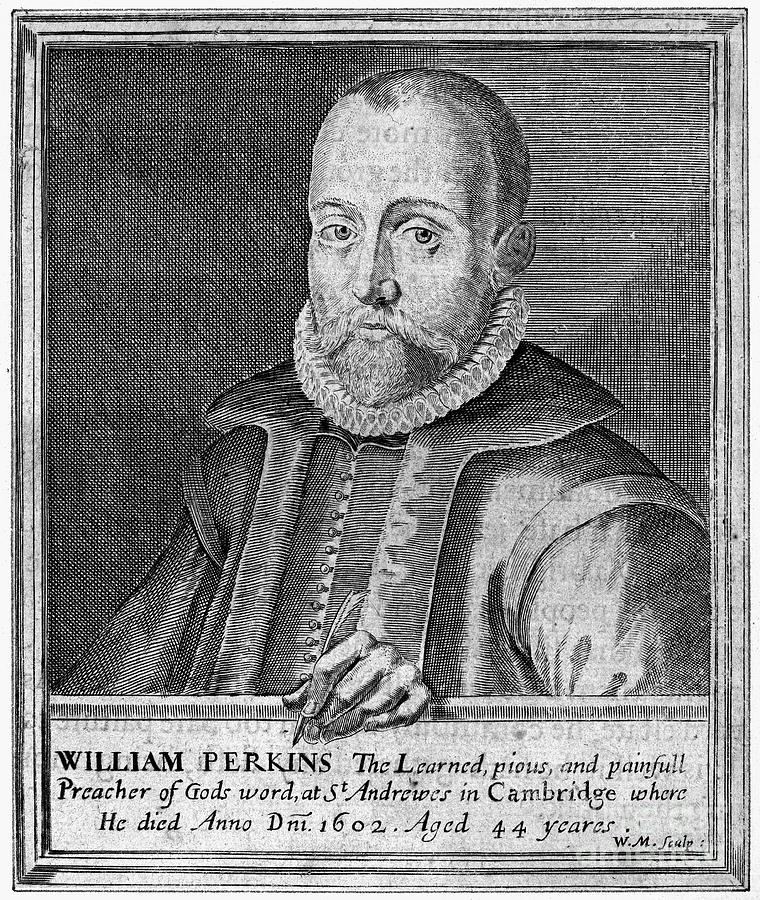Puritan Preachers: William Perkins

May 12, 2017
 No Puritan was more concerned about preaching than William Perkins (1558–1602). Detesting the substitution of eloquence for the “lost art” of preaching, Perkins led a reformation of preaching. He did this in his instruction to theological students at Cambridge; in his manual on preaching, The Arte of Prophecying (Latin: 1592; English 1606), which quickly became a classic among Puritans; in advocating a "plain style" of preaching in his own pulpit; and, above all, in stressing the experimental application of predestinarian doctrines.
No Puritan was more concerned about preaching than William Perkins (1558–1602). Detesting the substitution of eloquence for the “lost art” of preaching, Perkins led a reformation of preaching. He did this in his instruction to theological students at Cambridge; in his manual on preaching, The Arte of Prophecying (Latin: 1592; English 1606), which quickly became a classic among Puritans; in advocating a "plain style" of preaching in his own pulpit; and, above all, in stressing the experimental application of predestinarian doctrines. Joseph Pipa suggests three reasons why Perkins wrote his preaching manual. First, there was a “dearth of able preachers in Elizabethan England” (“William Perkins and the Development of Puritan Preaching.” PhD dissertation, Westminster Theological Seminary, 1985, p. 86). By 1583, only a sixth of English clergy were licensed to preach, and even in 1603 there were only half as many preachers as parishes. Second, there were gaps in the university curriculum, with particular deficiencies in theology, preaching, and spiritual direction. Third, Perkins aimed to promote a “plain” style of preaching as opposed to the ornate style of high-church Anglicans (Pipa, “William Perkins,” pp. 87–88); the latter heaped up quotations from ancient authorities, often in Greek or Latin, together with many puns, extravagant and surprising analogies, rhymes, and alliteration.
Perkins’s model of preaching influenced generations to come. We see in The Arte of Prophecying several themes that contributed to Reformed preaching. I will illustrate these themes from his Commentary on Galatians 5:24 (“And they that are Christ’s have crucified the flesh with the affections and lusts”), which is sermonic material edited for publication.
First, Perkins sets forth a high view of the Word of God. It is sufficient, pure, authoritative, and powerful while the sum of its message is the incarnate Christ and His saving work (The Art of Prophecying, in Workes, 2:731–732; Galatians, e.g., 4, 32, 139).
Second, Perkins calls preachers to study the Scriptures both accurately and wisely. Much of his preaching manual teaches principles of biblical interpretation. This must be: 1) theological, 2) broadly biblical—viewing any one text in the light of the teaching of the whole Bible, 3) historical, 4) prayerful, 5) literal and grammatical, 6) contextual, and 7) rhetorical—recognizing figures of speech (The Art of Prophecying, 736–749). For example, on Galatians 5:24 he opened by identifying the scope of the text (its purpose) as showing why no law puts a spiritual man under condemnation or bondage, thereby immediately connecting the text with the verse before it, “against such there is no law” (Gal. 5:23). He then interpreted the text to say that (1) “A Christian is one that is Christ’s”; (2) the flesh “is the corruption of the whole nature of man,” especially active in “inordinate and insatiable desires after the things of this world”; and (3) it is the work of a Christian man to crucify the flesh (Galatians, 397–98).
Third, Perkins instructs preachers to crystallize the meaning of the Scripture text into doctrine or distinct teaching. Some texts clearly express a doctrine. In other texts, the preacher may deduce doctrines through sound reasoning and logic. Doctrines derived from the Bible “by just consequence” should be confirmed by a few testimonies from other Scripture passages, but merely human testimonies do not have the authority to prove a point (The Art of Prophecying, 750–751).
We just saw above how Perkins’s interpretation of Galatians 5:24 led to three clear doctrines. He proceeded to develop these doctrines. For example, he listed five ways in which the Christian belongs to Christ: 1) by right of creation, 2) by right of redemption, 3) by the Father’s election and effectual calling, 4) by propagation from His blood, and 5) by our giving ourselves to Him in baptism (Galatians, 397).
Fourth, Perkins teaches preachers to make suitable application of the doctrine to people’s lives. The foundational question for application is whether the text is law or gospel. Law defines righteousness, exposes sin, and pronounces God’s curse on sin. Gospel reveals Christ and His benefits received by a fruitful faith (The Art of Prophecying, 752). Application came in many forms: 1) a positive doctrinal application, 2) a negative doctrinal application, 3) a positive practical application, and 4) a negative practical application (The Art of Prophecying, 756–758).
From Galatians 5:24 Perkins gave three “uses” for his first point on belonging to Christ, one for his second point on the flesh, four for his third point on crucifixion with Christ, and then ends with three more brief points on crucifying the flesh—eleven points of application for a single verse of Scripture. Unlike some Puritan preaching, he wisely scatters his applications throughout his exposition rather than reserving them all for the end after lengthy doctrinal discussions (Galatians, 397–400).
Another key to unlocking application is to consider the spiritual condition of those who hear the sermon. Perkins schematized listeners into seven categories (The Art of Prophecying, 752–756): 1) ignorant and unteachable unbelievers, 2) ignorant but teachable unbelievers, 3) those who have some knowledge but are not humbled, 4) the humbled, 5) those who believe, 6) those who are fallen, either in faith or in practice, 7) a mixed group.
Fifth, Perkins advises preachers to deliver their sermons with Spirit-worked liberty, sincerity, and power. He recommended that the preacher memorize an outline of his sermon and not be concerned about specific words. The minister should modestly conceal his scholarship, but preach with the demonstration of the Spirit (1 Cor. 2:1–5). He explained: “The demonstration of the Spirit is, when as the minister of the Word doth in the time of preaching behave himself, that all, even ignorant persons and unbelievers may judge that it is not him that speaketh, as the Spirit of God in him and by him.” Spiritual preaching speaks with simplicity, clarity, the fear of God’s majesty, and love for the people. It avoids Greek and Latin words, entertaining stories, and jesting. Instead, it displays dignity, seriousness, ability to teach, authority as God’s messenger, and “zeal, whereby being most desirous of God’s glory he doth endeavor to fulfill and execute the decree of election concerning the salvation of men by his ministry” (The Art of Prophecying, 758–761).
Lastly, Perkins calls ministers to preach Christ. He concluded: “The sum of the sum. Preach one Christ by Christ to the praise of Christ” (The Art of Prophecying, 762). In expositing Galatians 5:24, he preacheed Christ’s lordship over the saved soul; His redeeming death for sins; His providential care for His people and our committing ourselves to Him; and His conquering of our sins on the cross and in our hearts, and our imitation of Christ by faith in His finished work. Christ’s centrality and supremacy pervade his preaching, and in that Perkins is a model for us all.





